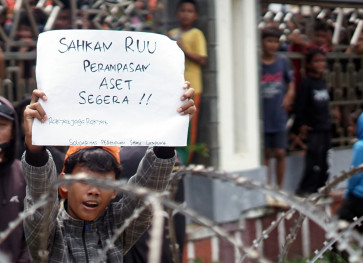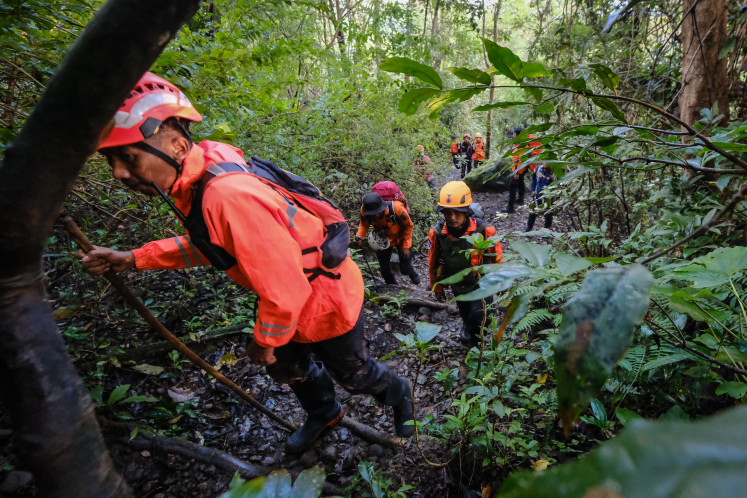Popular Reads
Top Results
Can't find what you're looking for?
View all search resultsPopular Reads
Top Results
Can't find what you're looking for?
View all search resultsLook after the forest, and it will look after you
Green path: A man walks right through Wonosadi communal forest in Beji village, Gunungkidul regency, Yogyakarta
Change text size
Gift Premium Articles
to Anyone
Green path: A man walks right through Wonosadi communal forest in Beji village, Gunungkidul regency, Yogyakarta.
At the peak of the dry season, several villages in Yogyakarta’s Gunungkidul regency are parched. But the people of Beji village in Ngawen district have a different experience.
Water keeps on flowing from the local springs even as the dry months grind on, giving the residents a sufficient supply for their farms and other daily needs. Several local fish species flourish in the small brooks the clear stream flows into.
With their water supply thus uninterrupted by the drought, the 3,000 residents of Beji are not among the millions of people around the world who must struggle for the 20 or 25 liters of potable water they need each day.
So why is Beji so blessed?
Within Beji is a communal forest, covering 25 hectares — the size of 51 soccer fields — called Wonosadi. Spreading over a hill, this forest has three water springs that meet the Beji community’s daily needs.
Surrounding Wonosadi is a 35-hectare buffer zone, with the function of reducing damage to the main forest.
“Locals may gather firewood in the buffer forest,” said 77-year-old Muhammad Kasno, a community leader.
On entering Wonosadi, the visitor treks up a steep path and is greeted by the amazing sight of a natural environment reminiscent of a pristine tropical rainforest in Sumatra.
Large trees of diverse species, including rare ones, grow densely, their tops touching each other in the canopy, tangled by the tendrils of climbing plants. As a result, sunlight finds it hard to penetrate, creating shady areas.
Seen from afar, Wonosadi shines green like an emerald, so the huge rocks within the forest are not visible, let alone the brown peat lining the forest ground. In the dry, barren and stony landscape of Gunungkidul, the presence of verdant Wonosadi is a startling anomaly.
Wonosadi is even more luxurious than Wanagama, owned by Gadjah Mada University in Yogyakarta, which is also located in Gunungkidul. The natural beauty of Wonosadi is one of the attractions that draw tourists to Beji, which has been a tourist village since 2006.
Rare beauty: The forest is home to Dendrobium secundum orchid locally nicknamed as “worm orchid”.
The well-conserved Wonosadi forest is an inseparable part of the local community’s stories. As Kasno tells it, around the 15th century, the Majapahit kingdom in East Java collapsed after being attacked by Central Java’s Demak kingdom. One of its chief ministers — who is said to have had supernatural powers — named Ki Onggoloco and his entourage fled and opened the forest zone where they lived.
This zone later became known as Beji.
But Ki Onggoloco and followers did not reclaim the whole forest, leaving Wonosadi unscathed because of its water springs.
“Ki Onggoloco sent out the message that this forest should remain intact to preserve its springs,” the Beji village elder said.
Belief in the legend of Ki Onggoloco and in the various spirits inhabiting the forest makes local people scared of damaging Wonosadi, thus leading to its conservation for generations.
Wonosadi did suffer some damage during the Japanese occupation near the end of World War II.
“It was a very hard time for the local economy, so people were forced to collect firewood from the forest to sell,” added Kasno.
After Indonesia’s independence, the forest was closed off and eventually it recovered. But in 1965, Kasno said, Wonosadi was ravaged by supporters of the Indonesian Communist Party (PKI) felling trees. He claimed it was a deliberate move by the group in an attempt to prove to locals that Wonosadi was neither a home to lost spirits nor Ki Onggoloco’s former abode.
In the post-1965 period, after the PKI was outlawed by the government, the Beji community members replanted Wonosadi. The reforestation project was directed by village administrators, including the chief of Beji’s Duren hamlet Siswanto Tukimin, who, Kasno said “played a major role in the restoration of Wonosadi”.
Various methods including a cultural approach were adopted to convince local people of the importance of protecting Wonosadi.
Later, Wonosadi was successfully rehabilitated and, in 2009, a Beji activist in the reforestation effort, Sudiyo, won an award from the Kehati Foundation as a conservation motivator.
Siswanto, 66, a local resident, said after the forest restoration, the three water springs, that had previously run dry, were revived.
“The three sources can now provide clean water for people in six hamlets within Beji,” he said.
He pointed out the spring called Pok Blembem, where water flows from behind a big black rock. “This is the largest spring,” he added.
Passing a mahogany tree about one meter in diameter, Siswanto said, “That one I planted along with fellow residents.” An inscription on the tree’s trunk reads it was planted in 1966.
Standing tall: Four giant munggur (Javanese tamarind) trees in the forest are said to be 500 years old.
At the center of Wonosadi is a plain, called Ngenuman, spanning 800 square meters. Four giant munggur (Javanese tamarind) trees stand there, their trunks ranging in diameter from 4 to 8 meters.
They are said to be 500 years old. Locals believe Ki Onggoloco once set up his shrine in Ngenuman, where Beji people gather in June to make offerings known as sadranan in his memory.
In addition to supplying clean water, Wonosadi is a natural pharmacy.
“Whatever the disease, it can be healed there,” claimed an aged farmer, Yanto Suwarno. Records show the forest has more than 75 types of plants used for herbal medicine.
With its 74 species of trees, 23 shrubs and 45 kinds of grass, Wonosadi also creates a bountiful habitat for different wildlife species. Kasno offered a list of 32 bird species, nine mammals, 28 reptiles and amphibians and more than 15 kinds of insects.
The existence of 21 types of ornamental plants also enhances Wonosadi’s beauty. Several orchid varieties are among these, but the favorite is an underground orchid named Pactelis susannae. In the dry season, it is a mere tuber hidden in the soil, but after the rains start, it blooms with white flowers.
The crystal clear water running through the brooks partly irrigates villagers’ farms, in which they grow groundnuts.
For the Beji community, the abundance offered by the forest confirms the truth of the myths behind it.
They have also gained the local wisdom from the valuable life lesson that looking after the forest is the key to survival in a region that otherwise seems destined to suffer recurrent dry spells.
— Photos by Bambang M.












